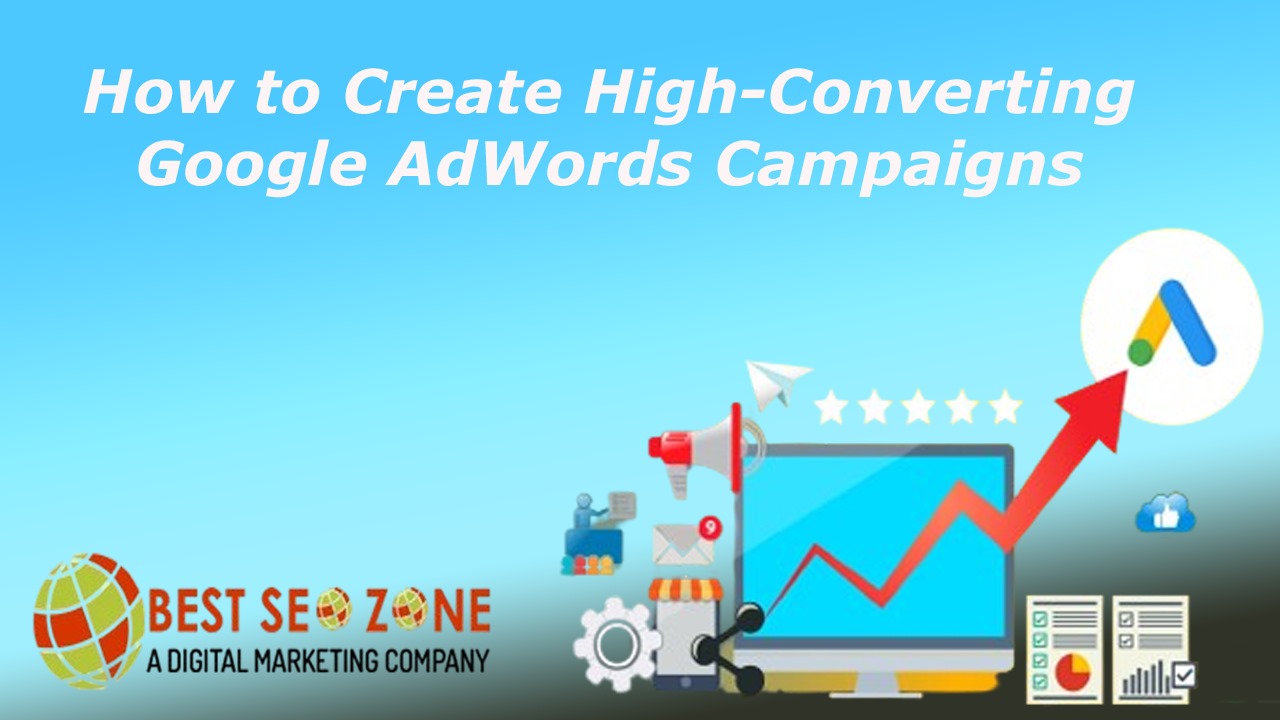Google AdWords now known as Google Ads is one of the most powerful online advertising platform available today.With billion of search happening every day it allow business of all size to reach potential customer at the exact moment they are searching for product or service. But simply running ads is not enough you need to create campaign that not only attract click but also convert those click into real result such as sale lead or inquiry.
The challenge lies in balancing reach relevance and ROI. Many advertiser make the mistake of targeting too broadly using generic ad copy or failing to optimize their campaign after launch. These error often lead to wasted budget and disappointing outcome. A high-converting Google Ads campaign require a structured approach that carefully align keyword targeting ad messaging and landing page experience.
If you are looking to get the most out of your ad spend you need a strategy that goes beyond basic setup.From understanding your audience deeply to crafting irresistible ad copy and optimizing for conversions every detail matter.In this guide we’ll explore proven strategy to build campaigns that not only generate click but also maximize conversion ensuring that every dollar you invest deliver real business growth.
Table of Contents
How to Create a Google Search Ads Campaign Step by Step for Maximum Results
Launching a successful Google Search Ads campaign is more than simply writing ads it requires strategic planning and proper setup.Below is a step-by-step guide to building a campaign that delivers real result.
Define Your Campaign Goal
The very first step is deciding what you want to achieve.Google Ads allow you to choose goal such as sale lead website traffic or brand awareness.Your choice will determine how the campaign is optimized.For example if you choose Lead Google will focus on actions like form submissions or call instead of just click.
Select the Campaign Type
For search campaign select the Search Network option.This ensures your ads appear when user type queries directly into Google search bar.It is the best choice if you want to capture people who are actively looking for your product or service.
Configure Campaign Settings
In this step you set the rule for your campaign:
- Budget Decide how much you are willing to spend daily.
- Location Targeting Show ads in specific countries cities or a custom radius.
- Language Target audiences by their preferred language.
- Search Partners Choose whether or not to include Google partner sites.
These settings control who sees your ads and how much you spend.
Create Ad Groups
Ad groups help you organize your campaign into smaller relevant categories.For example in a clothing campaign one ad group might be Men’s Shirts another Women Shoes.Each ad group should contain closely related keyword and ads making targeting more precise.
Choose the Right Keywords
Keyword are the foundation of search ads.Focus on high-intent long-tail keywords like buy running shoes online instead of broad ones like shoes.This ensures you reach people who are more likely to convert.Also use negative keywords to block irrelevant searche and avoid wasted spend.
Write Compelling Ads
Your ads should be attention-grabbing and persuasive.Write headlines that directly address user intent and description that highlight benefit.Always include a strong Call-to-Action (CTA) such as Buy Now Get a Free Quote or Sign Up Today.This nudges users toward taking immediate action.
Set Up Ad Extensions
Ad extensions make your ads more engaging by adding extra information like
- Sitelink Extensions Links to specific pages e.g.Pricing About Us.
- Call Extensions A phone number user can click to call directly.
- Location Extensions Show your business address or map location.
These small add-ons often improve click-through rate and conversion.
Launch and Monitor Your Campaign
Once your campaign is live the work is not over.Monitor performance using metrics like CTR Click-Through Rate CPC Cost Per Click and conversion.Optimize continuously by pausing low-performing ads adjusting bid and testing new ad variation.

Determining Where Your Google Ads Can Appear: Targeting the Right Audience in the Right Places
One of the greatest strengths of Google Ads is the control it gives you over where your ads appear.Unlike traditional advertising where your message might reach people who have little or no interest in your offer Google Ads allow you to decide exactly when and where your ads will show.This level of precision ensures that your budget is used to reach the most relevant audience.Placement targeting is not just about visibility it is about being present at the right time and place when your potential customer are actively searching for solution.
The most common and valuable placement is within Google own search results pages.Your ads can appear at the top or bottom of these page when user type in keyword you selected.This is incredibly powerful because it allow you to connect with people who already have high intentthey are actively searching for the product or service you provide.Google also offer the option to extend your ads to search partner sites which are third-party website that use Google search technology.While this can expand your reach the quality of traffic may vary so many advertisers test this option before committing significant budget.
Another layer of control come from device targeting which allow you to optimize campaign for desktop tablet or mobile user.Consumer behavior varies greatly depending on device many people research on desktop but complete purchases on mobile.By adjusting your bid for each device type you can maximize conversion without overspending.In short being selective about where your ads appear is not just a feature it is a strategy.The more carefully you define your targeting the more likely you are to reach high-intent user who are ready to click engage and convert.
Understanding the Google Search Ads Campaign Structure: Building the Framework for Success
Running ads on Google is not just about writing catchy headline and picking keywords it is about building a campaign that has a strong logical structure behind it.Many beginners dive straight into creating ads only to realize later that their campaign are messy confusing and hard to manage.That is why understanding the Google Ads hierarchy is one of the first and most important step toward success Google Ads is designed with layers that give advertisers complete control. At the top you have your account hich is the foundation of everything.Within that campaign allow you to focus on broader goal while ad group give you the power to organize keyword and ads into tightly themed categorie.
A well-structured campaign is like a blueprint for your advertising.It show you where to allocate budget how to test different messages and how to track performance with clarity.Without it you risk wasted spend poor targeting and confusion when analyzing data.
When advertisers understand this hierarchy scaling campaigns becomes simple. Instead of being overwhelmed by hundreds of ads you have a system where every part has a clear role and purpose.That is the difference between amateur setup and professional-grade campaigns.So before jumping into bidding strategies or ad copywriting take the time to build a strong foundation.The effort you put into structure at the start pay off in smoother management better targeting and higher return.
Key Components of the Google Ads Structure
- Stores billing details business information and user access.
- Acts as the central hub for all your advertising activity.
- Defines overall objective daily budget targeting location language networks.
- Each campaign usually represent a specific goal or promotion.
- Groups related keyword and ads together for tighter targeting.
- Ensures ad relevance for example an ad group for Men Jeans will only show jeans-related ads.
- Prevents wasted ad spend.
- Makes tracking and optimization more accurate.
- Keeps campaigns scalable and easier to manage over time.
Choosing the Right Bidding Strategy: Balancing Cost Control and Conversions
Think of your bidding strategy in Google Ads like the steering wheel of a car it decide where your budget goes and how fast you reach your destination. You can either keep your hands firmly on the wheel with full control manual bidding or let Google autopilot automated bidding guide you based on data and algorithms.Neither option is universally better it all depend on your goal experience and appetite for control.
Manual Bidding: You are in the Driver’s Seat
Manual CPC Cost Per Click gives you the freedom to decide exactly how much each keyword is worth to you. It is like telling Google I’ll pay $2 for this click but only $0.50 for that one.This level of control is perfect if you want to prioritize specific keyword or experiment with small budget.The downside? It can get exhausting especially if you are managing dozens of campaign and constantly adjusting bid.
Automated Bidding: Google as Your Co-Pilot
If manual bidding feel too heavy automated strategies step in to lighten the load.Take Maximize Clicks for example it aim to bring you as many visitor as possible within your set budget.This work well for new campaign where the goal is to build traffic and collect performance data.Over time as you gather insight you can shift to smarter automation strategie designed to improve conversion.
Smart Bidding: Let AI Do the Heavy Lifting
For advertisers focused on profitability Google Target CPA Cost Per Acquisition) and Target ROAS (Return on Ad Spend) are game changers.These strategies use Google machine learning to optimize in real time showing your ads to the people most likely to convert.Target CPA ensures you pay roughly the amount you want for each lead or sale while Target ROAS ensures that the money you put in comes back multiplied in revenue.However these method work best once you already have a healthy amount of conversion data for Google AI to learn from.
Finding Your Balance
There’s no one-size-fits-all bidding strategy.Beginners often start with Manual CPC or Maximize Clicks to test the waters and gather data.Once enough performance history is built transitioning to Target CPA or Target ROAS usually brings better efficiency.The key is to treat bidding as a dynamic process. It is not a set it and forget it switch it is a balancing act between cost control and conversions constantly fine-tuned as your campaigns evolve
Setting Up Your Google Ads Account the Right Way for Long-Term Growth
Setting up a Google Ads account may seem like a quick technical step but in reality it’s the foundation of every campaign you’ll ever run. A weak setup leads to messy data wasted money and frustration later on. A strong setup on the other hand gives you clarity control and the ability to scale with confidence. Think of it like laying the foundation of a house—without it the whole structure is at risk.
The first step is creating your account properly. Instead of using a personal email always link Google Ads to a business email. This not only looks professional but also makes it easier to give team members access as your business grows. From there the setup process begins to shape how smooth your journey will be.
Here are five critical parts of getting your Google Ads account ready for long-term success:
- Billing Setup Done Right – Choose your currency time zone and payment method carefully because once selected these settings can’t be changed later. Mistakes here can lead to reporting errors and budget confusion.
- Analytics and Conversion Tracking – Linking Google Analytics and enabling conversion tracking lets you measure real business results like purchases or leads not just clicks.
- Clear Naming Conventions – Instead of “Campaign 1” or “Ad Group A” use descriptive names like “US – Summer Promo – Search.” This makes scaling easier and avoids confusion.
- Tightly Themed Ad Groups – Keep ad groups focused on one keyword theme. For example a clothing store might create separate ad groups for “Men’s Jackets” and “Women’s Shoes.”
- User Access and Permissions – Set permissions correctly from the start so team members can collaborate without risking accidental changes or billing issues.
By paying attention to these details early you save yourself from headaches later. Many advertisers rush through setup and then struggle with messy accounts inconsistent tracking or unclear reports. But when your account is organized from day one scaling become effort you can add more campaign test new strategies and analyze performance with complete confidence.
In short the effort you put into setting up your account is an investment in your future result.Just like a well-built foundation support a skyscraper a properly structured Google Ads account support long-term growth.
Final thought: Turning Strategy into Action
Google Ads success does not happen overnight it is built on smart setup the right strategie and consistent optimization.By laying a solid foundation choosing the right bidding method and targeting the right audience you set yourself up for long-term growth.Now it is your turn to put these step into action and turn click into real result.

Dilshad Mushtaq is the founder and CEO of Best SEO Zone which is a prominent digital marketing agency based in Pakistan Since 2010. He is a professional website developer & Digital Marketer who can create any website and rank it on Google Page One.




